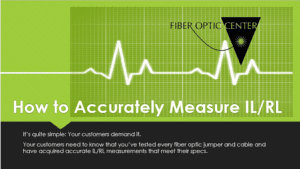Why is it important to measure Insertion Loss and Return Loss?
It’s quite simple: Your customers demand it. Your customers need to know that you’ve tested every fiber optic jumper and cable and have acquired accurate IL/RL measurements that meet their specs. Why is this important to them? Systems won’t work if inadequate power reaches the receiver at the far end of the path. (The receiver could be a data center, metro link within a city, or undersea communication system.) When you test IL/RL, you are measuring the physical power characteristics of the cable – but not how well the cable transmits data.
Insertion Loss (IL) is the loss of power due to adding a jumper.
Fundamentally, Insertion Loss is the loss of power that results from inserting a cable into a network or transmission path. Keep in mind that, inevitably, some power is lost because every connection represents a break in the fiber optic system. That’s why your production process must minimize Insertion Loss. You want to see low Insertion Loss measurements, which indicate that the path or system is performing with the least errors. If a cable connection has a high Insertion Loss, the power at the receiving end can start to increase the bit error rate.
Return Loss (RL) is a measure of power reflected.
Return Loss is a measure of the relative power reflected back from a splice, connection, or defect in the fiber. In the early days, this was a big problem. Lasers could be destabilized by power coming back at them, and analog video would suffer ghosts. This is largely a thing of the past, and measuring RL is something of a historical remnant. In fact – and it may be controversial to say this – measuring Return Loss is no longer critical. Today, good (high) RL numbers are regarded as a mark of quality. If a connector shows poor RL, it may still perform adequately, but this indicates something is not quite right with the process. If you are not getting high RL measurements, I encourage you to investigate your production process. Also, it’s possible that good RL may contribute to long-term reliability, although I don’t have concrete evidence to support this.

To help ensure accurate IL measurements, use good-quality test jumpers.
Only the loss of a connection can be measured – a mated pair of connectors. (It’s impossible to measure a single connector.) Therefore, to qualify the performance of a jumper, other cables must be used, and the quality of those cables will affect the measurement you get for your device under test (DUT). I recommend you purchase good-quality jumpers from an established first-tier manufacturer. In addition to being the same size, launch jumpers should use the same fiber type. For Multi-Mode, use test jumpers built with single-mode connector hardware.
To help ensure accurate RL measurements, use OTDR.
To measure Return Loss, some means of isolating the connector part of the reflected signal is required: a mandrel wrap, index matching gel, or Optical Time Domain Reflectometer (OTDR).
- A mandrel wrap is impossible to use with thick cables – Early instruments relied on using a mandrel wrap to choke off further reflections. This referencing works well enough for thin, single-fiber jumpers, but thicker multi-fiber cables cannot be mandrel wrapped tightly enough to be effective.
- Gel is difficult with many connector types – Index matching gel works for simple cables, but it’s difficult for complex connectors such as MTP/MPO male or Lemo. Plus, this method is messy and requires cleaning time.
- Today, OTDR is the universally preferred method to measure Return Loss – Any sort of cable/connector can be accurately measured using an OTDR, provided the device under test is not too short (~0.5um).
For best results, always clean the device before testing.
I’ve heard it said that 95% of problems in measurement are due to contamination. Based on my 40 years of experience in the fiber optic industry, I believe it’s more like 99.99%. Train your production staff to always inspect and clean the device before conducting a measurement test. Cleaning will give you the best and most accurate measurement. In the long run, this will speed up your process.
To accurately measure IL/RL, using a high-quality tester is imperative.
At Fiber Optic Center, we recommend the Viavi MAP200 Passive Component Tester to measure IL/RL. Viavi (formerly JDSU) has been producing IL/RL meters for at least 20 years. In fact, they initially built this tester for their own internal use, because suitable equipment was not available for the new products they were developing. This company’s experienced team (of which I was once a part) continually improves this highly reliable instrumentation. My customers and I find that it has all the tools you need, and Fiber Optic Center will help you get the best out of it. In fact, this is my promise to my customers: When you buy test equipment from us, I’ll make sure you succeed at using it.
Do you have a specific issue regarding meeting your desired IL/RL specs? We are here to help! Send us your question, and we’ll do our best to provide guidance. FOC is committed to helping you manufacture the best fiber optic cable assemblies possible.
FOC is a resource for questions on this and all technical subjects. AskFOC can be found at: https://focenter.com/askfoc/ where our technical experts answer your questions.
Read: What Causes Poor IL/RL?



